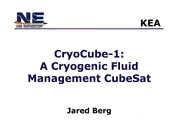
NASA Technical Reports Server (NTRS) 20130013661: CryoCube-1: A Cryogenic Fluid Management CubeSat PDF
Preview NASA Technical Reports Server (NTRS) 20130013661: CryoCube-1: A Cryogenic Fluid Management CubeSat
KEA CryoCube-1: A Cryogenic Fluid Management CubeSat Jared Berg CryoCube Project Intro KSC ENGINEERING AND TECHNDLDGY: • CubeSat platform • Cryogenic fluid management experiments - Fluid location sensing - Slosh characterization - Cryogenic fluid transfer • Cooperative effort between private industry and NASA • SLI: Design, fabrication, major component procurement • KSC: Analysis, radio communications hardware • Principle Investigators - Jared Berg- NASA - Phil Putman- Sierra Lobo 2 CryoCube Project Intra KSC ENGINEERING AND TECHNOLOGY • CryoCube-1 (CC-1) - Liquid oxygen (LOX) working fluid - Solid-to-gas generator - Low temperature experiment tank • Instruments - Cryo-Trackersensor - In-tank camera • Features Combination sun shield I solar cell array - Magnet-torquer attitude control - Majority commercial off the shelf (COTS) components • Selected for CubeSat Launch Initiative (CSLI) - Launch manifested 2014 3 CryoCube Project Intro • Goal: Analyze thermal performance of CC-1 Reduce experiment tank temperatures into regime appropriate for LOX condensation(< 119 K@ 1 MPa) • Passive cooling only • Lowweight Oxygen Phase Plot • Small size 1o.o .. _ L • Investigate design f f -- v / -/ / - / ~/- .-,;-.-;:-·~- sensitivity to I I --- I ~ ·-- - I I material and optical 1.00 aca. r- properties !. liquid Operating ......... ! Region .......... ..,....,....- •:I 1- • Determine effects of • ~·· ! /~ different orbit a. 0.100 parameters • Develop preliminary operational 0.0100 guidelines 100. 120. 140. Temperature (K) 4 Energy Balance KSC ENGINEERING AND TECHNOLOGY • Radiation follows Stefan-Boltzmann relation q = EaAI1T4 Albedo Solar IR a =Average albedo of Earth G= Solar radiation q =Earth IR 5 1R p = Earth view angle A=Area at= Solar absorptivity of top Et =Emissivity of top Ka =Albedo factor (0.664 + 0.521 p- 0.203 p2) T =Temperature ab =Solar absorptivity of bottom cb = Emissivity of bottom 5 Considerations • Angular size of Earth - Like having face 10" away from 55" TV and trying not to look 2Q =136oat h = 500 km - High relative temperature (250K) - Sun shield ineffective for Earth IR • Reflections - Reflective insulation bounces radiation into unwanted areas - Complicated arrangements hard to visualize mentally • Materials comparison - Intuitive "best" choice may not be optimal - Absorption and re-emission 6 Design Space • Actuated doors - Must expose tank directly to deep space - Permanently exposed tank absorbs too much Earth IR Active doors can open in eclipse, closed rest of orbit - Optical properties of inside and outside of • Shield - Rounded edges - Single regular shield will not block Earth IR - Large shield, middle mounted tank? - Double shield? - Shields can reflect radiation back onto tank • Tank - Round or cylindrical? - Effectiveness of fins • Isolation between segments - Material - Length 7 Current Design KSC ENGINEERING AND TECHNOLOGY • Cylindrical tank - Better view factor than sphere - Number of fins optimized • Double shield - Blocks all Earth IR in eclipse - Small stowage space • Active doors - Open during eclipse - Adaptable behavior - Requires power and control • Isolation - Long G-10 standoffs separate structure - Multi-layer insulation (MLI) MLI between segments - More complicated structure 8 Results KSC ENGINEERING AND TECHNOLOGY • Pseudo-steady state reached at 100,000-120,000 s from 293K • Below 119K limit • Slight cooling trend continues asymptotically T•nk Chllldown 116.2 290 116 280 115.8 11 270 115.6 I \ 260 115.4 ~ \ I \ 250 115.2 \ I \ 115 240 \ I \ 114.8 230 \ I \ \ 114.6 ~B.; 222100 \ ~ie~l- 111144..42 \ \ \ I I I \ \ \ I I I E.E~, 129000 \" ~ 11131.48 \ \ I I \ \ I I f" 180 ~ 113.6 \ \ I 113.4 \ I \ I 170 I'\ 113.2 \ / \ v 160 \ ..... 113 \ / / 150 112.8 \ / / \.~-.. 112.6 140 / \ / '- 112.4 130 \/ \ / 120 ~ ""' -- - ,.. ..... ..... 1-o.. 11121.22 v 0.0 2.0 4.0 6.0 8.0 10.0 12.0 14.0 16.0 18.0 20.0 22.0 24.0 26.0 28.0 30.0 32.0 111.8 31 31.5 32 32.5 33 Time (hours) Time (hours) 9 Future Work • Model refinement - Adjusting materials, conductors, and geometry based on prototype testing - Adding additional components - Adding fully-coupled fluid system model of gas generator system to capture condensation (Feasibility determined by hand calcs) • Testing - Precisely measure heat loads and parasitic sources - Determine coefficients for contact conduction • May reduce conduction but increase radiation - Qualify systems for vacuum operation • Validation - Full system testing in vacuum chamber - Check model accuracy - Refine margins 10
